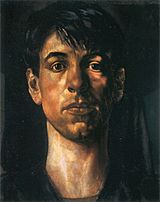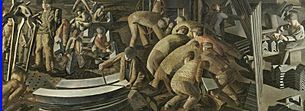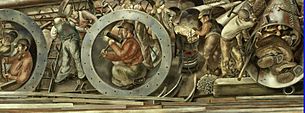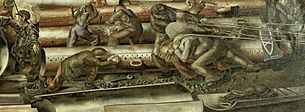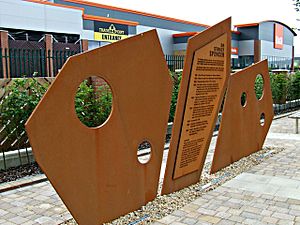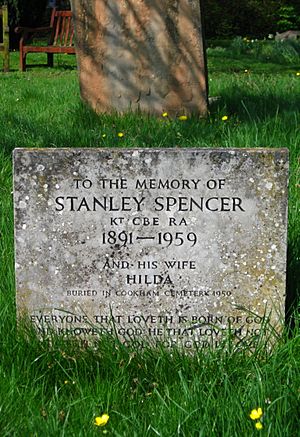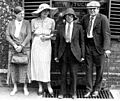Stanley Spencer facts for kids
Quick facts for kids
Sir Stanley Spencer
|
|
|---|---|
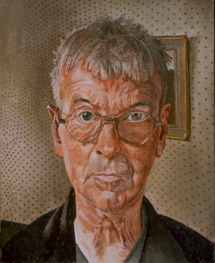
Self-portrait, 1959
|
|
| Born | 30 June 1891 Cookham, England
|
| Died | 14 December 1959 (aged 68) Cliveden, Buckinghamshire, England
|
| Education |
|
| Known for | Painting, drawing |
|
Notable work
|
The Resurrection, Cookham |
| Awards | RA 1950; CBE 1950; Knighted 1959 |
| Patron(s) | Louis and Mary Behrend |
Sir Stanley Spencer (born June 30, 1891 – died December 14, 1959) was a famous English painter. He was known for his unique paintings that showed Bible stories happening in his home village of Cookham. This small village was located next to the River Thames where he was born and lived most of his life. Spencer called Cookham "a village in Heaven." In his paintings, people from his village appeared as characters from the Bible.
Spencer was very good at painting many people in one scene. You can see this in his large paintings for the Sandham Memorial Chapel. This chapel was a memorial for the First World War. He also created the Shipbuilding on the Clyde series during the Second World War. These paintings were commissioned by the War Artists' Advisory Committee.
As he grew older, Spencer often painted landscapes to earn money. He kept his strong attention to detail, much like the Pre-Raphaelite artists. Spencer's art often showed his deep Christian faith. He remained an independent artist and did not join any art groups of his time. However, he did show some of his works in a big art exhibition in 1912.
Contents
- Early Life and Art Training
- Stanley Spencer and World War I
- Life and Art in the 1920s
- The Sandham Memorial Chapel
- Return to Cookham and New Ideas
- Later Life and Art Projects
- Resurrection Paintings After the War
- Final Years and Legacy
- Art Market and Archives
- Exhibitions of Stanley Spencer's Work
- Images for kids
- See also
Early Life and Art Training
Stanley Spencer was born in Cookham, Berkshire. He was the eighth child of William and Anna Caroline Spencer. His father, known as Par, was a music teacher and church organist. Stanley's younger brother, Gilbert Spencer, also became a well-known artist.
Stanley was taught at home by his sisters because his parents did not want him to go to the local school. However, Stanley and Gilbert took drawing lessons from a local artist named Dorothy Bailey. In 1907, Stanley started attending Maidenhead Technical Institute.
From 1908 to 1912, Spencer studied art at the Slade School of Fine Art in London. Many other famous artists were his classmates there. He loved Cookham so much that he often took the train home every day for tea. His friends even nicknamed him "Cookham."
In 1912, Spencer showed his painting John Donne Arriving in Heaven at an exhibition in London. The same year, he painted The Nativity and won a prize for it. He also started Apple Gatherers, which was shown in an art exhibition the next year. In 1914, he painted Zacharias and Elizabeth and The Centurion's Servant. The latter painting included Spencer himself, his brothers, and furniture from his own home. He also began a self-portrait, Self-portrait (1914), which was bought by art collector Edward Marsh.
Stanley Spencer and World War I
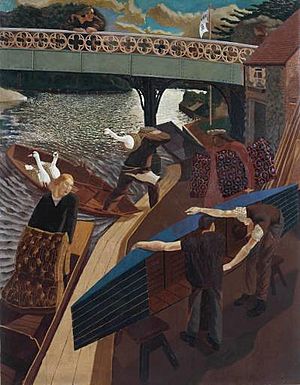
When the First World War began, Spencer wanted to join the army. In 1915, he volunteered for the Royal Army Medical Corps (RAMC). He worked as an orderly at the Beaufort War Hospital in Bristol. After 13 months, Spencer was sent overseas to Macedonia in 1916. He served with a medical unit.
In 1917, he joined an infantry unit, the 7th Battalion, the Berkshire Regiment. Spencer spent two and a half years fighting on the front line in Macedonia. He faced both German and Bulgarian soldiers. He later left the army due to repeated illnesses. The war deeply affected Spencer. His older brother, Sydney, died in action in 1918. These experiences influenced his later paintings about life and death.
Spencer returned to England in late 1918. He went back to Cookham and finished Swan Upping, a painting he had started before the war. He found it hard to paint after his wartime experiences. He often said, "It is not proper or sensible to expect to paint after such experience."
Painting Travoys Arriving with Wounded
In 1919, Spencer was asked to paint a large artwork for a planned Hall of Remembrance. The painting was called Travoys Arriving with Wounded at a Dressing Station at Smol, Macedonia, September 1916. It is now in the Imperial War Museum. This painting clearly showed Spencer's experiences in the medical corps.
He wrote about the scene: "The wounded passed through the dressing stations in a never-ending stream." He used an old Greek church as a setting, making it look like the birth of Christ. But for Spencer, the wounded soldiers on stretchers reminded him of Christ on the Cross. The work of the surgeons represented the Resurrection. He said, "I meant it not a scene of horror but a scene of redemption." He also felt "there was grandeur" in the scene, and the wounded men were "calm and at peace."
Life and Art in the 1920s
Spencer lived in Cookham until 1920. Then he moved to Bourne End and stayed with Henry Slesser. There, he painted about 20 pictures, including Christ Carrying the Cross, which is now in the Tate museum. In 1921, he worked on designs for a war memorial.
In 1923, Spencer worked on more war memorial designs. These designs led to a commission from Louis and Mary Behrend. They wanted paintings for a chapel in Burghclere, Berkshire, to honor Mary's brother who died in the war. This chapel would be called the Sandham Memorial Chapel.
In October 1923, Spencer rented a studio in Hampstead. He began working on The Resurrection, Cookham. In 1925, Spencer married Hilda Carline, who was also an artist. They had two daughters, Shirin (born 1925) and Unity (born 1930).
The Resurrection, Cookham Painting
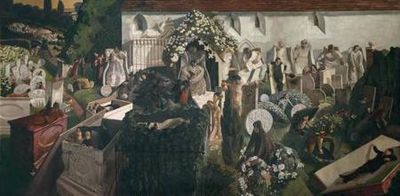
In February 1927, Spencer had his first solo art show. The main painting was The Resurrection, Cookham. It received excellent reviews. A critic from The Times called it "the most important picture painted by any English artist in the present century."
This huge painting is set in the churchyard of Holy Trinity Church in Cookham. It shows Spencer's friends and family rising from their graves. God, Christ, and saints watch over them. Some people are climbing over a fence, others are going to the river to board a boat. Spencer painted Hilda, his wife, three times in the picture. The exhibition was a big success, and many paintings were sold. The Resurrection, Cookham was bought by Lord Duveen, who gave it to the Tate. After the show, Spencer moved to Burghclere to start work on the Sandham Memorial Chapel.
The Sandham Memorial Chapel
The Sandham Memorial Chapel in Burghclere was a very large project. Spencer's paintings cover a huge end wall, eight curved sections above smaller paintings, and two long, narrow strips between the curved sections and the ceiling. The Behrends, who commissioned the chapel, were very generous. They paid for the chapel to be built to Spencer's plans. They also paid for his London studio and built a house for him and Hilda near the chapel. Spencer painted the canvases directly in the chapel. The chapel was designed like Giotto's Arena Chapel in Padua.
The 16 paintings in the chapel are arranged on opposite walls. The series starts with a scene of soldiers arriving at Beaufort Hospital. It continues with scenes of kit inspection and life in Macedonia. Spencer did not paint heroic battle scenes. Instead, he showed the everyday life in camp or hospital, like Scrubbing the Floor and Bedmaking. He focused on the sense of friendship he found during the war. The painting The Dugout shows his hope for peace.
The scene Map Reading shows soldiers resting by a road. Bilberry bushes in the background make the scene look green and peaceful. This seems to hint at the paradise promised in the Resurrection of the Soldiers on the end wall. Spencer imagined the Resurrection of the Soldiers happening outside a village in Macedonia. Soldiers rise from their graves and hand white crosses to a figure of Christ. Working on the chapel was a six-year process for Spencer. He explained the focus on the resurrection: "I had buried so many people and saw so many bodies that I felt death could not be the end of everything."
While working at Burghclere, Spencer also took on other small jobs. He painted a series of five pictures about Industry and Peace in 1929. He also made 24 pen-and-ink sketches for a book in 1927. Much later, he turned seven of these sketches into paintings, including The Dustbin, Cookham in 1958.
Return to Cookham and New Ideas
By 1932, Spencer was back in Cookham with his two daughters and Hilda. They lived in a large house called Lindworth. Here, Spencer painted scenes of his surroundings and landscapes. These became important themes in his art for years to come. In 1932, he became a member of the Royal Academy and showed ten works at the Venice Biennale.
During the First World War, Spencer had started thinking about a special chapel of peace and love to display his art. These ideas grew stronger while he worked at Burghclere. He eventually planned a complete building called the "Church-House." It would mix his love for Cookham with paintings about different kinds of love. The building would have mirrored the geography of Cookham. It would include bedrooms as chapels, fireplaces as altars, and decorated bathrooms. Other versions of the plan were more like an English church. He planned chapels for people important in his life. Even though the building was never built, Spencer kept working on paintings for it throughout his life.
Many paintings were meant for the Church-House. This included two paintings Spencer sent to the Royal Academy in 1935: Saint Francis and the Birds and The Dustman or The Lovers. The Royal Academy rejected both pictures, and Spencer resigned from the Academy in protest. The rejection of the Saint Francis picture was especially upsetting because his own father was the model for Saint Francis.
Later Life and Art Projects
In October 1938, Spencer moved to London. He stayed with friends and then in a small rented room. During this time, he painted four canvases for his Christ in the Wilderness series. He had planned to paint 40 pictures for this series, but only eight were finished. By September 1939, he was staying in Gloucestershire with artists George and Daphne Charlton. Spencer created many important works there, including Us in Gloucestershire and The Wool Shop. He also started a series of over 100 pencil drawings, known as the Scrapbook Drawings.
Shipbuilding on the Clyde Series
Since late 1938, Spencer's agent, Dudley Tooth, had been managing his money. When the Second World War started, he helped Spencer find work with the War Artists' Advisory Committee (WAAC). In May 1940, WAAC sent Spencer to the Lithgows Shipyard in Port Glasgow on the River Clyde. His job was to paint the civilians working there. Spencer was fascinated by what he saw. He suggested painting a huge series of up to 64 canvases.
WAAC agreed to a smaller series of up to 11 canvases, some of which would be very long. The first two, Burners and Caulkers, were finished by August 1940. WAAC bought Burners and asked for another painting, Welders. Spencer delivered Welders in March 1941. WAAC thought very highly of Spencer's work.
Between trips to Port Glasgow, Spencer rented a room in Epsom. He wanted to move back to Cookham and work in his old studio. WAAC helped him financially to do this. By May 1942, Spencer delivered Template, followed by 12 portraits of people from Clydeside in October 1942.
By June 1943, Spencer was having trouble with the next painting, Bending the Keel plate. WAAC bought it in October 1943. Around this time, the shipyard owner, James Lithgow, complained about Spencer's paintings of his shipyard. WAAC then asked another artist, Henry Rushbury, to paint more traditional views of shipbuilding. Spencer made more visits to Glasgow. By June 1944, he had finished Riggers and started Plumbers. After the war, the complete Shipbuilding on the Clyde series was given to the Imperial War Museum.
In November 2006, the Imperial War Museum asked Sir Alex Ferguson to help raise money to restore Spencer's shipyard paintings. The Riverside Museum in Glasgow now displays Spencer's shipyard paintings. In 2014, a memorial made of steel was put up for Spencer at the former Kingston Shipyard in Port Glasgow.
In 1945, Spencer returned to live in Cookham in a house called Cliveden View.
Resurrection Paintings After the War
The idea of resurrection had always been important in Spencer's art. After the war, it became even more so. He wrote in his notebooks about a special moment in Port Glasgow. He said, "I walked up along the road past the gas works to where I saw a cemetery on a gently rising slope... I seemed then to see that it rose in the midst of a great plain and that all in the plain were resurrecting and moving towards it." He knew then that the resurrection would be guided from this hill.
Spencer's original idea for this vision needed a very wide painting. Since that was not practical, he started a series of paintings of different sizes. The two largest, Resurrection: The Hill of Sion and Resurrection: Port Glasgow, were each about 22 feet long. He also created a series of three-part paintings called triptychs, including Reunion and Rejoicing. Spencer wanted all these paintings to be shown together, but each one was sold to a different collector or gallery. Resurrection: Port Glasgow was shown with the Shipbuilding on the Clyde series for the first time in 2000.
Final Years and Legacy
In 1950, Spencer was made a CBE. He also rejoined the Royal Academy. In the early 1950s, Spencer visited his elder brother Harold in Northern Ireland. He painted portraits and urban scenes there, like Merville Garden Village near Belfast in 1951.
In 1954, the Chinese government invited Spencer and other Western visitors to China. Spencer told Zhou Enlai that he felt at home in China because "Cookham is somewhere near, only just around the corner." In late 1955, a large exhibition of Spencer's work was held at the Tate. He then began a series of large paintings for his Church-House project, centered on Christ Preaching at Cookham Regatta.
In his later years, Spencer was known as a "small man with twinkling eyes and shaggy grey hair." He was often seen "wandering the lanes of Cookham pushing the old pram in which he carried his canvas and easel." A painting called Homage to Spencer shows him pushing his easel in a pram, surrounded by angels. His old pram is now on display at the Stanley Spencer Gallery in Cookham, which is dedicated to his life and works.
In 1958, Spencer painted The Crucifixion. This painting was set on Cookham High Street and first shown in Cookham Church. It was one of his most powerful paintings. Spencer received an honorary degree from Southampton University in 1958. Three days later, he was knighted at Buckingham Palace.
In December 1958, Spencer was diagnosed with cancer. He had an operation in 1959. He painted a final self-portrait from July 12 to July 16, 1959. Self-Portrait (1959) shows a strong, determined person. Spencer died of cancer in December 1959. At the time of his death, Christ Preaching at Cookham Regatta was still unfinished. Spencer was cremated, and his ashes were buried in Cookham churchyard. A stone memorial marks the spot.
Art Market and Archives
The value of Spencer's paintings greatly increased after a major exhibition at the Royal Academy in 1980. For example, The Resurrection; waking up sold for £770,000 in 1990. His Crucifixion (1958) sold for £1,320,000 in May 1990, setting a record for a modern British painting. In 2011, Sunflower and Dog Worship sold for £5.4 million.
In 1973, the Tate museum acquired many of Spencer's family archives. These included his notebooks, sketchbooks, and letters. Spencer loved making lists, and the archive has lists related to his paintings, his Church-House project, and even plants in his art. Other letters are kept at the Stanley Spencer Gallery in Cookham. Tate Britain has the largest collection of Spencer's works in the world. However, the Stanley Spencer Gallery always has the largest collection on display.
Exhibitions of Stanley Spencer's Work
Here are some of the exhibitions of his work:
- 1927: Goupil Gallery
- 1932: Venice Biennale
- 1936: Tooth's Gallery, Bond Street
- 1938: Venice Biennale
- 1939: Leger Gallery
- 1947: Retrospective at Temple Newsam House, Leeds
- 1954: Arts Council exhibition
- 1955: Tate retrospective
- 1958: Exhibition at Cookham church and vicarage
After his death, many exhibitions have been held:
- 1980: Royal Academy
- 1981: Spencer in the Shipyard, Arts Council touring exhibition
- 1997: Stanley Spencer: An English Vision, Smithsonian Institution, Washington D.C.
- 2000: Men of the Clyde:Stanley Spencer's Vision at Port Glasgow, Scottish National Portrait Gallery
- 2001: Tate Britain retrospective
- 2002: Love, Desire, Faith, Abbothall Gallery, Kendel
- 2008: Laing Art Gallery
- 2009: York Art Gallery
- 2009: Sargent, Sickert & Spencer, The Fitzwilliam Museum, Cambridge
- 2011: Stanley Spencer And The English Garden, Compton Verney House
- 2013: Heaven in a Hell of War, Somerset House
- 2013-14: Stanley Spencer in Cookham, Stanley Spencer Gallery
- 2014: Paradise Regained, Stanley Spencer Gallery
- 2015: The Creative Genius of Stanley Spencer, Stanley Spencer Gallery
- 2016: Stanley Spencer: Of Angels & Dirt, The Hepworth Wakefield
- 2016: Stanley Spencer: a twentieth century British Master, Carrick Hill, Adelaide, Australia
Images for kids
See also
 In Spanish: Stanley Spencer para niños
In Spanish: Stanley Spencer para niños


